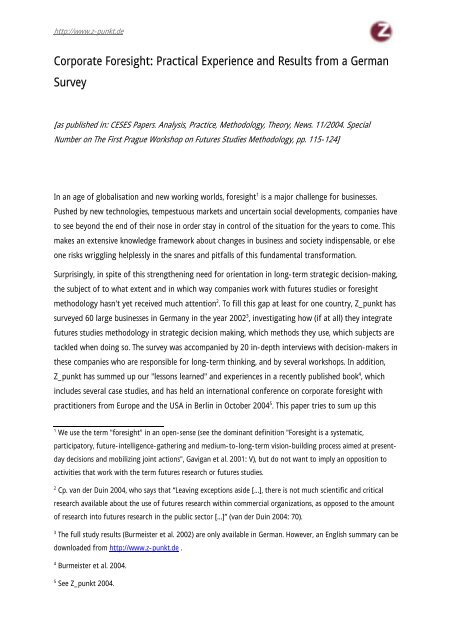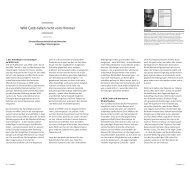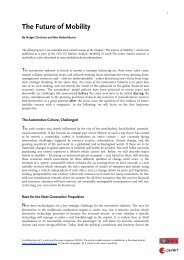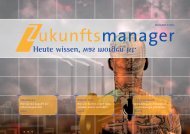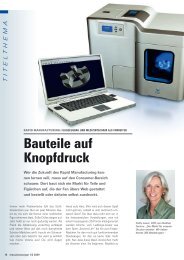Corporate Foresight: Practical Experience and Results ... - Z_punkt
Corporate Foresight: Practical Experience and Results ... - Z_punkt
Corporate Foresight: Practical Experience and Results ... - Z_punkt
You also want an ePaper? Increase the reach of your titles
YUMPU automatically turns print PDFs into web optimized ePapers that Google loves.
http://www.z-<strong>punkt</strong>.de<br />
<strong>Corporate</strong> <strong>Foresight</strong>: <strong>Practical</strong> <strong>Experience</strong> <strong>and</strong> <strong>Results</strong> from a German<br />
Survey<br />
[as published in: CESES Papers. Analysis, Practice, Methodology, Theory, News. 11/2004. Special<br />
Number on The First Prague Workshop on Futures Studies Methodology, pp. 115-124]<br />
In an age of globalisation <strong>and</strong> new working worlds, foresight 1 is a major challenge for businesses.<br />
Pushed by new technologies, tempestuous markets <strong>and</strong> uncertain social developments, companies have<br />
to see beyond the end of their nose in order stay in control of the situation for the years to come. This<br />
makes an extensive knowledge framework about changes in business <strong>and</strong> society indispensable, or else<br />
one risks wriggling helplessly in the snares <strong>and</strong> pitfalls of this fundamental transformation.<br />
Surprisingly, in spite of this strengthening need for orientation in long-term strategic decision-making,<br />
the subject of to what extent <strong>and</strong> in which way companies work with futures studies or foresight<br />
methodology hasn't yet received much attention 2 . To fill this gap at least for one country, Z_<strong>punkt</strong> has<br />
surveyed 60 large businesses in Germany in the year 2002 3 , investigating how (if at all) they integrate<br />
futures studies methodology in strategic decision making, which methods they use, which subjects are<br />
tackled when doing so. The survey was accompanied by 20 in-depth interviews with decision-makers in<br />
these companies who are responsible for long-term thinking, <strong>and</strong> by several workshops. In addition,<br />
Z_<strong>punkt</strong> has summed up our "lessons learned" <strong>and</strong> experiences in a recently published book 4 , which<br />
includes several case studies, <strong>and</strong> has held an international conference on corporate foresight with<br />
practitioners from Europe <strong>and</strong> the USA in Berlin in October 2004 5 . This paper tries to sum up this<br />
1<br />
We use the term "foresight" in an open-sense (see the dominant definition "<strong>Foresight</strong> is a systematic,<br />
participatory, future-intelligence-gathering <strong>and</strong> medium-to-long-term vision-building process aimed at presentday<br />
decisions <strong>and</strong> mobilizing joint actions", Gavigan et al. 2001: V), but do not want to imply an opposition to<br />
activities that work with the term futures research or futures studies.<br />
2<br />
Cp. van der Duin 2004, who says that “Leaving exceptions aside […], there is not much scientific <strong>and</strong> critical<br />
research available about the use of futures research within commercial organizations, as opposed to the amount<br />
of research into futures research in the public sector […]” (van der Duin 2004: 70).<br />
3 The full study results (Burmeister et al. 2002) are only available in German. However, an English summary can be<br />
downloaded from http://www.z-<strong>punkt</strong>.de .<br />
4 Burmeister et al. 2004.<br />
5 See Z_<strong>punkt</strong> 2004.
http://www.z-<strong>punkt</strong>.de<br />
knowledge <strong>and</strong> research results (as far as possible in this short from), with a focus on major challenges<br />
for corporate foresight <strong>and</strong> on problems which seem to occur typically in corporate foresight activities<br />
throughout different sectors. In answer to these challenges, a model of 5 key factors for the success of<br />
such activities is introduced: the “5C-Model of <strong>Corporate</strong> <strong>Foresight</strong>”, highlighting the aspects of<br />
competence, creativity, communication, cooperation <strong>and</strong> continuity.<br />
II. <strong>Corporate</strong> <strong>Foresight</strong> today – the most important results of Z_<strong>punkt</strong>'s 2002 survey<br />
In Z_<strong>punkt</strong>'s 2002 survey, 60 companies 6 in Germany were questioned in writing, <strong>and</strong> a further 20<br />
specialist interviews were carried out with company representatives. Moreover, two workshops were<br />
conducted to analyse the results with the interviewees <strong>and</strong> discuss conclusions. All in all, 26 companies<br />
were fully involved in the survey. To sum up the results: <strong>Corporate</strong> <strong>Foresight</strong> activities in Germany are<br />
in many places still wallflowers, but with large chances for <strong>and</strong> tendencies to growth.<br />
Motivations for <strong>Corporate</strong> <strong>Foresight</strong><br />
Businesses work with foresight in order to:<br />
• build a knowledge base (reduce uncertainty by identifying new <strong>and</strong> relevant trends, create<br />
orientation on future developments),<br />
• prepare strategic decisions,<br />
• support innovation processes,<br />
• develop new <strong>and</strong> future business fields / markets.<br />
Summing up results from the answers to the survey as well as discussions in the workshop, on can say<br />
that there is a rising awareness for the complexity of interactions between companies <strong>and</strong> their<br />
environments, which is a major motivation to implement corporate foresight. In addition, companies<br />
more <strong>and</strong> more realize the need to overcome a technology-centred perspective, which has dominated<br />
R&D as well as strategic foresight activities in many sectors for a long time. Discussions such as the<br />
one about possible health hazards of mobile phones <strong>and</strong> the problems of acceptance connected to it<br />
have made the business world more aware of their interconnectedness with the “wider environment”.<br />
6 These were large corporations, as these are the main active players in the corporate foresight field in Germany,<br />
while SMEs are still reluctant to take up foresight activities.
http://www.z-<strong>punkt</strong>.de<br />
Issues companies tackle in corporate foresight<br />
One main point of interest was the question of what kind of subjects corporations deal with in their<br />
corporate foresight activities. To come to a rough indication whether the focus is really shifting from<br />
technology to a more open perspective, we asked the participants of the survey to rank five thematic<br />
fields in terms of their importance in corporate foresight activities. Concerning these issues, a clear list<br />
of priorities took shape:<br />
1. Technology <strong>and</strong> Innovation<br />
2. Business & Companies<br />
3. Individuals & Society<br />
4. Environment & Nature<br />
5. Politics <strong>and</strong> Law<br />
Today, companies keep their closest watch on the fields of "technology & innovations" <strong>and</strong> "business &<br />
companies". At the bottom are "environment" <strong>and</strong> "politics & law", while "individuals & society" can be<br />
found in the middle. Observation of technological progress obviously still is the most important issue<br />
in corporate foresight, especially within one's own sector. Ranked after are new management<br />
techniques <strong>and</strong> one's own role in the framework of internationalisation <strong>and</strong> globalisation. This is in<br />
turn followed by the whole field of changes in social politics <strong>and</strong> their effects on individuals, in other<br />
words: changes in values <strong>and</strong> lifestyle demographic change, <strong>and</strong> new working worlds. Currently, issues<br />
of sustainable development <strong>and</strong> environmental changes are apparently less interesting, the same goes<br />
for new st<strong>and</strong>ards in politics <strong>and</strong> law.<br />
This shows a perspective from the inside to the outside, concentrating on the environment in close<br />
proximity, on the closer competitive environment, as in marketing <strong>and</strong> management practice.<br />
Technology <strong>and</strong> Innovation is still at the centre, but wider environmental fields dealing with subjects<br />
such as changes in society, values <strong>and</strong> living styles follow closely behind, hinting at a growing thematic<br />
openness <strong>and</strong> a wider perspective. And, not to be forgotten: 70 % of the surveyed businesses deal with<br />
all 5 subject areas, which shows that the “outside-in-perspective” is gaining ground 7 .<br />
7<br />
Cp. Liebl (2004), who stresses the importance of the interrelations between three areas of strategic knowledge<br />
(knowledge about the customers <strong>and</strong> their "worlds", knowledge about the resources <strong>and</strong> competences of the<br />
focal company, <strong>and</strong> the knowledge about trends <strong>and</strong> issues in the company's environment, the latter being<br />
gained from an outside-in perspective).
http://www.z-<strong>punkt</strong>.de<br />
Methods used<br />
A large part of the literature on corporate foresight concentrates on scenarios as the central<br />
instrument. However, the study shows that a wide range of methods 8 is being used regularly by the<br />
surveyed companies:<br />
• Publication Analysis ( cp. environmental scanning) (used regularly by 79%)<br />
• Brainstormings (58%)<br />
• Scenario Methods (46%)<br />
• Simulations (29%)<br />
• Trend Extrapolation (29%)<br />
• Expert Surveys or Interviews (33%)<br />
• Delphi (only seldomly) by 42%<br />
• Future Workshops 8%<br />
30 % of the surveyed companies use external studies <strong>and</strong> services in their corporate foresight<br />
activities. The most interesting results of this part of the study show that, when compared to the<br />
outcomes of a previous survey in Germany9 , it is obvious that more methods are known as well as more<br />
methods are used regularly . For example, Delphi methods were only used by 15% in 1996 <strong>and</strong> this<br />
percentage rose to 42% in 2002, paralleled by an increase of the use of scenario techniques from 58 to<br />
96% 10 .<br />
To sum up, in these parts, the favourite methods of future studies according to the survey are scenario<br />
technique, brainstorming, <strong>and</strong> specialist interviews. According to the answers to the survey, they make<br />
it possible to systematically evaluate influences <strong>and</strong> disruptive factors on particular visions for the<br />
future, for instance consequences of technological breakthroughs for products, markets, <strong>and</strong> customer<br />
behaviour.<br />
In general, qualitative methods seem to be gaining ground in corporate foresight. This result is in tune<br />
with other studies <strong>and</strong> seems to parallel developments in other countries. Becker (2003: 4) even speaks<br />
of a “preference of methods based on the interaction between different (internal or external players<br />
8<br />
This quotes the answers given by surveyed companies – it may be discussed whether methods included here are<br />
"original" foresight or futures studies <strong>and</strong> research methodologies (for example brainstormings) – however, they<br />
were perceived as such by the surveyed corporations.<br />
9 This study was conducted by the Sekretariat für Zukunftsforschung with two survey rounds, one in 1996 <strong>and</strong><br />
one in 1999.<br />
10 This percentage (also shown in figure I) refers to methods used at all, not methods used regularly.
http://www.z-<strong>punkt</strong>.de<br />
that are rather person- <strong>and</strong> communication-orientated” on the European level. However, he also<br />
stresses that “quantitative instruments are still widely used in specific areas” (Becker 2003: 5). The<br />
much-discussed realization that predictions (<strong>and</strong> the purely quantitative methodology they often base<br />
upon) cannot grasp the future <strong>and</strong> cannot inform present-day decision-making in a turbulent<br />
environment, is mirrored in this shift, <strong>and</strong> parallels developments on other areas. While policy<br />
development seems to become more participatory, strategic planning <strong>and</strong> decision-making also seems<br />
to move to "more evolutionary approaches" (Gavigan et al. 2001: 5) – as well as corporate foresight<br />
seems to be moving more in this direction.<br />
Figure I: Methods Used in <strong>Corporate</strong> <strong>Foresight</strong> 1996, 1999, 2001; Source: Burmeister et al. 2002<br />
Actors <strong>and</strong> organizational structure<br />
Considering the relative newness of this field of corporate activity, it seems no wonder that especially<br />
large corporations, which undergo a fast <strong>and</strong> profound change, are interested in future studies – for<br />
example telecommunication, insurance, <strong>and</strong> the media –, while in the tourism industry <strong>and</strong> retail<br />
business the whole issue still rather goes to waste, speaking generally <strong>and</strong> with exceptions. Around<br />
30% of the interviewed companies had departments for future studies with fixed staff; the rest relies<br />
on small teams or individuals (several answers were possible):<br />
• 79% work with a specialised employee<br />
• 75% use project groups for a fixed period<br />
• 38% have a changing responsibility of employees<br />
• 29% work with a group of employees
http://www.z-<strong>punkt</strong>.de<br />
However, despite the obviously growing number of corporate foresight departments or project groups,<br />
most of the corporate foresight activities are still conducted on a project basis (with a limited<br />
duration), changing responsibilities seem to be the rule <strong>and</strong> not the exception, <strong>and</strong> a single person<br />
responsible for corporate foresight is also quite often to be found. This leads to the conclusion that,<br />
although corporate foresight is on the rise in Germany, it is often not really embedded on a large scale<br />
<strong>and</strong> still suffers from a „wallflower status“.<br />
Futures activities belong to all kinds of departments <strong>and</strong> are relevant to their work, mainly for / to:<br />
• Strategy,<br />
• Innovation,<br />
• Marketing,<br />
• R & D.<br />
Obviously, the affiliation of corporate foresight groups, departments or individuals within their<br />
company has consequences for what is being done, in terms of time horizons, subjects as well as<br />
methods. For example, corporate foresight activities conducted at marketing departments tend to have<br />
shorter time horizons, while those at innovation department often us scenario methods concentrating<br />
on future products.<br />
II. Key Challenges<br />
“This does not concern our business”, “We don’t have time for this kind of imaginative playing around”,<br />
“This is just another fancy of the board of directors” <strong>and</strong> „The results do not help today‘s decisions“ –<br />
these are the most common statements against corporate foresight. Even if some of them are based on<br />
misperceptions, the frequency <strong>and</strong> persistence with which such statements are being voiced hints at a<br />
core problem: it is still unclear in many places how <strong>and</strong> why foresight might be helpful <strong>and</strong> relevant<br />
to corporations – a basic questions still seems to be unanswered or at least answers haven’t yet<br />
reached a large part of the business community.<br />
Connecting this to the more practical problems of implementing foresight in corporations, it seems<br />
that a number of problems occur regularly <strong>and</strong> across all sectors. One can differentiate between two<br />
types of problems: on the one h<strong>and</strong>, methodological problems, on the other h<strong>and</strong>, problems of more<br />
practical implementation. The problems most often quoted in relation to methodology <strong>and</strong> results are:<br />
• quantitative results are expected, but often not possible; scepticism towards qualitative<br />
methods is still present,
http://www.z-<strong>punkt</strong>.de<br />
• lack of knowledge about available methods <strong>and</strong> their applicability for which kinds of aims <strong>and</strong><br />
questions, being enforced by a lack of continuity, “reinventing the wheel”,<br />
• there is usually no systematic collection /scanning of data <strong>and</strong> sources: knowledge<br />
management problems,<br />
• the methodological „bridge“ to established business processes seems to be missing (problems in<br />
connecting foresight activities to established activities <strong>and</strong> methods, for example innovation<br />
management): no „action“ following the activity,<br />
• Difficulty to find the really important subjects <strong>and</strong> trends; insecurity about contents <strong>and</strong><br />
processes,<br />
• “vague <strong>and</strong> insufficient results with a lot of effort”.<br />
The problems of more practical implementation include:<br />
• main framework question are often not clarified: objective, time horizon, scope, etc.; too much<br />
openness <strong>and</strong> broadness as a pitfall,<br />
• budget limitations, lack of support in the company,<br />
• lots of explaining <strong>and</strong> „PR for futures activities“ are needed internally, while at the same time<br />
the “wallflower status” calls for a high level of personal enthusiasm <strong>and</strong> endurance.<br />
It seems obvious that a number of these problem arise from or are connected to the fact that the field<br />
still suffers from the above-mentioned wallflower-status. Changing responsibilities, a lack of<br />
connection to other activities go h<strong>and</strong> in h<strong>and</strong> with the phenomenon of “re-inventing the wheel”, as<br />
knowledge cannot be built upon <strong>and</strong> passed on. However, what seems most striking is the stress on<br />
what can be called “soft factors”, such as problems with communication <strong>and</strong> connection to further<br />
action. This was one of the main outcomes of the workshops that were conducted with practitioners<br />
that participated in our study: the main problems in corporate foresight do not lie in weaknesses of<br />
results, but in an insecurity of how to connect them to strategic decision making <strong>and</strong> to actors in the<br />
corporations. To sum this up: main problems of corporate foresight today lie in a (at least perceived)<br />
lacking methodological “bridge” to strategic decision making as well as in the general problem of a<br />
lack of connection within the corporation as a whole.<br />
III. The “5 C Model” for <strong>Corporate</strong> <strong>Foresight</strong><br />
These outcomes, especially those referring to main problems in corporate foresight, confirmed our<br />
observations that the success of any corporate foresight activity depends 50% on results <strong>and</strong> content
http://www.z-<strong>punkt</strong>.de<br />
matters <strong>and</strong> 50% on the communication of those <strong>and</strong> processes matters, thus: on “soft factors” 11 . The<br />
conclusion is simple: Content <strong>and</strong> process questions need more attention. While a lot of the literature<br />
on corporate as well as public foresight has so far focussed on methodological questions, this second<br />
area seems to have been neglected – especially in its interconnectedness to the success of corporate<br />
foresight. However, a number of new articles now tackles these kinds of "framework questions" (for<br />
example Liebl 2004; Cunha et al. 2004).<br />
Based on the survey’s results, on our experience in projects with clients <strong>and</strong> on the outcomes of<br />
workshops dealing with this field of foresight activity, Z_<strong>punkt</strong> has developed a framework for<br />
corporate foresight in answer to these challenges. This is the so called “5 C Model”, highlighting 5 main<br />
factors needed for corporate foresight activities in order to be successful. These factors are:<br />
• Competence: Competence in methods, contents <strong>and</strong> processes (with transparency of methods<br />
as a central factor),<br />
• Creativity: Deliver inspiring <strong>and</strong> new results, not only “business as usual scenarios”,<br />
• Communication: Find <strong>and</strong> use new ways of communication apart from reports,<br />
• Cooperation: include a variety of participants in the activity (guaranteeing a variety of<br />
perspectives as well as providing better chances of implementation),<br />
• Continuity: establish a learning culture, adapt ways of working to needs, optimise methods<br />
<strong>and</strong> results continuously.<br />
In short: in order to successfully deal with the future in a business environment, competence in<br />
methodology, process management <strong>and</strong> in the subjects to be dealt with is the basis, <strong>and</strong> a balance<br />
between these three fields of focus should be sought. The obvious deficit in knowledge about available<br />
methods has to be eliminated, as this threatens the success of any futures activity.<br />
11 Other sources hint into the same direction. For example, Wright et al. (2004) show that there are certain<br />
factors which makes companies more or less receptive towards scenario exercise, <strong>and</strong> that factors such as<br />
“strategic inertia” threaten the success of scenario exercises.
http://www.z-<strong>punkt</strong>.de<br />
Figure II: The 5-C-Model of <strong>Corporate</strong> <strong>Foresight</strong> Success Factors<br />
Creativity is needed in order to leave the path of “business as usual scenarios” <strong>and</strong> deliver inspiring <strong>and</strong><br />
new outcomes, so that, again, a balance needs to be established between working methodologically<br />
sound, systematically <strong>and</strong> with outcomes that are relevant to today’s business practice on the h<strong>and</strong><br />
<strong>and</strong>, on the other h<strong>and</strong>, delivering visionary, inspiring <strong>and</strong> newly orientating results.<br />
Thirdly, effective communication is needed to answer <strong>and</strong> overcome scepticism concerning foresight<br />
activities <strong>and</strong> to make results lead to action . Obviously, new ways of communication become of<br />
central importance (living scenarios, futures maps, future movies, futures installations <strong>and</strong> workshops,<br />
…), as insufficient communication of results within the corporation was named one the key challenges.<br />
Another central aspect is the need of those “doing futures” in companies to overcome their status as<br />
“lone riders”, fighting on their own, so that cooperation within (<strong>and</strong> even outside) the company should<br />
be widened. This also has positive effects on the possibilities to implement any actions deriving from a<br />
futures project – simply because chances for putting things into action are much higher if a larger<br />
number of actors in key positions have been part of the activity.<br />
Continuity, as the last point, makes it possible to establish a learning culture, to prevent reinventing<br />
the wheel over <strong>and</strong> over, to continuously adapt processes <strong>and</strong> methods to the needs of the company<br />
concerned, <strong>and</strong> thereby deliver practical, relevant <strong>and</strong> helpful outcomes.
http://www.z-<strong>punkt</strong>.de<br />
IV. Conclusions<br />
The summed up results of Z_<strong>punkt</strong>’s 2002 survey have shown that <strong>Corporate</strong> <strong>Foresight</strong> is on the rise in<br />
Germany. In addition, there is a re-orientation from a technology-centred towards a more holistic<br />
perspective, as well as a tendency to use more qualitative methods <strong>and</strong> combine <strong>and</strong> link these with<br />
<strong>and</strong> to the established quantitative approaches. <strong>Practical</strong> experience as well as other sources seem to<br />
show that this is more or less the case in many other countries as well 12 . For example, the conference<br />
“in the long run” has brought together practitioners from the field from the USA <strong>and</strong> Europe,<br />
exchanging <strong>and</strong> discussing experiences. Representatives from companies such as Volkswagen, Deutsche<br />
Bank, Telekom, Shell <strong>and</strong> Philips Design reported on their corporate foresight activities – showing a<br />
variety of organizing forms <strong>and</strong> a growing knowledge of methods which are known, used, being<br />
improved in the process <strong>and</strong> even invented. For example, Shell works with combining scenario methods<br />
to real options analysis (Cornelius 2004: 12). Philips Design works with the concept of open innovation,<br />
moving from a technology-centred perspective to a “more human centric <strong>and</strong> social focused approach”<br />
in their foresight activities (Green 2004: 14). Deutsche Telekom uses corporate foresight in a holistic<br />
approach within their innovation strategy development (Aukes 2004: 23), while BASF continually<br />
develops <strong>and</strong> works with a number of regional as well as global scenarios (Heinzelbecker 2004). Ove<br />
Arup & Partners have developed user-centric-processes (Luebkeman 2004: 30), Deutsche Bank works at<br />
the connection of quantitative <strong>and</strong> qualitative methodology in their project “Global Growth Centres”<br />
(Schneider 2004: 43).<br />
Some other conferences or workshops have proven the same point of the professionalisation <strong>and</strong><br />
growing implementation of corporate foresight, for example the two Strathclyde International<br />
Conferences on Organizational <strong>Foresight</strong> 13 (in the year 2002 <strong>and</strong> 2004) or the EU-US Scientific<br />
Seminar on New Technology <strong>Foresight</strong> 14 , which also featured a number of contributions from the<br />
private sector. A further not-so-weak signal concerning this trend is the growing interest in an<br />
exchange of experiences, as evident for example in the work of a German network of practitioners (the<br />
so-called Rauchfangswerder Gespräche, co-managed by Z_<strong>punkt</strong>), or of the Association of Professional<br />
Futurists or the <strong>Corporate</strong> <strong>Foresight</strong> Network 15 .<br />
This observation implies a positive outlook of a growing future orientation, especially as it is paralleled<br />
by a comparable growing interest in foresight in the public sector (see for example the German project<br />
12 See for example Becker (2003) for an analysis overview of corporate foresight in Europe or van der Duin (2004)<br />
for a case study from the Netherl<strong>and</strong>s.<br />
13 See the Website of the last conference: http://www.gsb.strath.ac.uk/worldclass/foresight/2004/ .<br />
14 EU-US Scientific Seminar: New Technology <strong>Foresight</strong>, Forecasting & Assessment Methods in May 2004:<br />
http://www.jrc.es/home/foresight_seminar/introduction.htm. ,<br />
15 See the Website of the <strong>Corporate</strong> <strong>Foresight</strong> Network: http://www.corporateforesight.net/ .
http://www.z-<strong>punkt</strong>.de<br />
“Futur” by the German Federal Ministry for Science <strong>and</strong> Education 16 , the activities in the field of<br />
regional foresight all over Europe 17 or the foresight initiatives in the new member states of the<br />
European Union 18 ). However, foresight activities <strong>and</strong> implementation still face a number of problems<br />
<strong>and</strong> challenges (<strong>and</strong> most of the above-mentioned apply in public sector foresight projects as well). The<br />
obvious tendencies for growth in public as well as private sectors call for a stronger exchange of<br />
experiences as well as for a answers to the problems named above. What is interesting is that the<br />
development in private <strong>and</strong> public sector does have more in common than the simple tendency for<br />
growth, such as, for example, the shared growing awareness for the need to widen the horizon, the<br />
tendency to include a variety of actors in the process, <strong>and</strong> the orientation towards social <strong>and</strong> societal<br />
developments replacing a focus on technology forecasts.<br />
There is, quite obviously, a number of gaps that need to be closed in order to face the abovementioned<br />
challenges: the gap between the amount of already existing methodological work <strong>and</strong> the<br />
lack of knowledge about it, the gap between the foresight / futures research <strong>and</strong> futures studies<br />
community <strong>and</strong> their work results <strong>and</strong> its practical applications in business <strong>and</strong> public sectors 19 . The<br />
gap between the persisting “report culture” in many foresight activities <strong>and</strong> the need for action <strong>and</strong><br />
communication on the other h<strong>and</strong> also seems a major challenge. In addition, there is a low level of<br />
diffusion <strong>and</strong> a low extent of practical use in businesses in general (if one includes SMEs in the<br />
perspective, <strong>and</strong> / or looks at non-western countries), while the state of the art of the “lead user”<br />
development of corporate foresight evolves rapidly. But, what seems more important: the link of<br />
corporate foresight to strategic decision making <strong>and</strong> other areas of activity such as innovation<br />
development needs to be strengthened <strong>and</strong> explored further, as, obviously, the need for these kinds of<br />
activities is growing at the moment. As has been introduced in the 5C-Model for <strong>Corporate</strong> <strong>Foresight</strong>,<br />
success with such kinds of activities not only depends on methods <strong>and</strong> content questions, but also to<br />
an often underestimated extent on social <strong>and</strong> process factors. A major threshold for corporate<br />
foresight not only in Germany in order to grow <strong>and</strong> become even more successful therefore lies in the<br />
16 This is "FUTUR – The German Research Dialogue", a topic-generating process for the definition of research<br />
projects of the German Federal Ministry of Science <strong>and</strong> Education, see http://www.futur.de<br />
17 For an overview, see for example Keenan/Uyarra 2002, or the Website http://www.regional-foresight.de/ on<br />
"Europe's Regions Shaping the Future - the Role of <strong>Foresight</strong>".<br />
18 See for example eForesee, a project which wants to "address challenges faced by policy makers implementing<br />
foresight activities for smaller economies <strong>and</strong> regions": http://www.eforesee.info .<br />
19<br />
Bridging gaps towards the technology assessment community can be added to this list – see Malanowksi et al.<br />
2002 for a summary of the application of technology assessment in corporations in several countries <strong>and</strong> their<br />
future perspectives. The authors also come to the conclusion that more dialogue <strong>and</strong> cooperation between the<br />
business <strong>and</strong> the scientific community is needed.
http://www.z-<strong>punkt</strong>.de<br />
connection of the qualitative <strong>and</strong> the quantitative as well as in developing flexible yet stable<br />
frameworks for corporate foresight.<br />
Cornelia Daheim 20 ,<br />
Contact:<br />
Z_<strong>punkt</strong> GmbH The <strong>Foresight</strong> Company<br />
Bullmannaue 11; 45327 Essen; Germany<br />
fon +49 (0)201 747 27-12; fax +49 (0)201 747 27-22; http://www.z-<strong>punkt</strong>.de; daheim@z-<strong>punkt</strong>.de<br />
Bibliography<br />
Aukes, Hans Albert 2004: Innovation @ Deutsche Telekom. In: Z_<strong>punkt</strong> The <strong>Foresight</strong> Company (eds.)<br />
2004: Abstracts from “in the long run. International Conference on Long-Term Thinking in Business:<br />
<strong>Corporate</strong> <strong>Foresight</strong> <strong>and</strong> Global Change”. Essen, Berlin 2004. P. 21-23.<br />
Becker, Patrick 2003: <strong>Corporate</strong> <strong>Foresight</strong> in Europe: A First Overview. European Commission<br />
Community Research Working paper. Luxembourg 2003<br />
Burmeister, Klaus; Neef, Andreas; Albert, Bernhard; Glockner, Holger 2002: Zukunftsforschung und<br />
Unternehmen. Praxis, Methoden, Perspektiven. Ed. by Z_<strong>punkt</strong> GmbH. Essen 2002 ( available in German<br />
only; a summary of the main results in English can be downloaded from: http://www.z-<strong>punkt</strong>.de)<br />
Burmeister, Klaus; Neef, Andreas; Beyers, Bert 2004: <strong>Corporate</strong> <strong>Foresight</strong>. Unternehmen gestalten<br />
Zukunft. Hamburg 2004<br />
Cornelius, Peter 2004: Three Decades of Scenario Planning at Shell: <strong>Experience</strong> <strong>and</strong> Possible Extensions<br />
for the Future. In: Z_<strong>punkt</strong> The <strong>Foresight</strong> Company (eds.) 2004: Abstracts from “in the long run.<br />
International Conference on Long-Term Thinking in Business: <strong>Corporate</strong> <strong>Foresight</strong> <strong>and</strong> Global Change”.<br />
Essen, Berlin 2004. P. 10-11<br />
20<br />
Cornelia Daheim is Project Manager (for International Research) at Z_<strong>punkt</strong> GmbH The <strong>Foresight</strong> Company in<br />
Essen, Germany. Z_<strong>punkt</strong> supports institutions <strong>and</strong> organizations in long-term strategic planning with futures<br />
studies services, <strong>and</strong> is also active as the German Node of the Millennium Project at the American Council for the<br />
United Nations University ( http://www.stateofthefuture.org).
http://www.z-<strong>punkt</strong>.de<br />
Cunha, Migueal Pina e; Palma, Patricia; da Costa, Nuno Guimaraes 2004: Tracking Changes in<br />
Organizational <strong>Foresight</strong>. (Conference paper, presented at the 2nd international conference on<br />
Organizational <strong>Foresight</strong> Graduate School Of Business, University Of Strathclyde 2004, <strong>and</strong> available at<br />
the website http://www.gsb.strath.ac.uk/worldclass/foresight/2004/<br />
van der Duin, Patrick A. 2004: Innovating for the Future. In: Thinking creatively in turbulent times. Ed.<br />
By Howard A. Didsbury <strong>and</strong> the Staff of the World Future Society. Bethesda 2004. P. 70-82.<br />
Fichter, Klaus; Kiehne, Dierk-Oliver 2004: Trendmonitoring im Szenario-Management. Eine erste<br />
Best<strong>and</strong>saufnahme informationstechnischer Unterstützungspotenziale. Stuttgart 2004<br />
Gavigan, James P; Sciapolo, Fabiana; Keenan, Michael; Miles, Ian; Farhi, Francois; Lecoq, Denis; Capriati,<br />
Michele; Di Bartolomeo, Teresa (Eds.) 2001: A <strong>Practical</strong> Guide to Regional <strong>Foresight</strong>. Seville 2001<br />
Glenn, Jerome C.; Gordon, Theodore J. 2003: Futures Research Studies Methodology. Version 2.0. CD-<br />
ROM. Washington 2003<br />
Green, Josephine 2004: Unlocking the Future: Technology <strong>and</strong> Social Research <strong>and</strong> Innovation. In:<br />
Z_<strong>punkt</strong> The <strong>Foresight</strong> Company (eds.) 2004: Abstracts from “in the long run. International Conference<br />
on Long-Term Thinking in Business: <strong>Corporate</strong> <strong>Foresight</strong> <strong>and</strong> Global Change”. Essen, Berlin 2004. P. 13-<br />
15<br />
Keenan, Michael; Uyarra, Elvira 2002: Why Regional <strong>Foresight</strong>? An Overview of Theory <strong>and</strong> Prctice.<br />
Paper prepared for the STRAT-ETAN Expert Group on "Mobilisingg the regional foresight potential for<br />
an enlarged Eueopan Union. Bruxelles 2002.<br />
Liebl, Franz 2004: Organizational <strong>Foresight</strong> as Strategic Knowledge Management: A Frame of Reference<br />
(Conference paper, presented at the 2nd international conference on Organizational <strong>Foresight</strong><br />
Graduate School Of Business, University Of Strathclyde 2004, <strong>and</strong> available at the website<br />
http://www.gsb.strath.ac.uk/worldclass/foresight/2004/).<br />
Luebkeman, Chris 2004: Can you imagine? <strong>Experience</strong> from Arup’s Global <strong>Foresight</strong> <strong>and</strong> Innovation<br />
Team. In: Z_<strong>punkt</strong> The <strong>Foresight</strong> Company (eds.) 2004: Abstracts from “in the long run. International<br />
Conference on Long-Term Thinking in Business: <strong>Corporate</strong> <strong>Foresight</strong> <strong>and</strong> Global Change”. Essen, Berlin<br />
2004. P. 29-30<br />
Malanowski, Norbert; Krück, Carsten P.; Zweck, Axel (eds.) 2001: Technology Assessment und<br />
Wirtschaft. Eine Länderübersicht. Frankfurt, New York 2001<br />
Pertrásek, Frantisek 2004: Forecasting <strong>and</strong> Decisionmaking: A Permanent Problem. Paper for the First<br />
Prague Workshop on Futures Studies Methodology, distributed at the conference.<br />
Schneider, Stefan 2004: A Search for Future Growth Centres – Exp<strong>and</strong>ing Strategic <strong>Foresight</strong> in<br />
Banking. In: Z_<strong>punkt</strong> The <strong>Foresight</strong> Company (eds.) 2004: Abstracts from “in the long run. International
http://www.z-<strong>punkt</strong>.de<br />
Conference on Long-Term Thinking in Business: <strong>Corporate</strong> <strong>Foresight</strong> <strong>and</strong> Global Change”. Essen, Berlin<br />
2004. P. 33-34<br />
Tsoukas, Haridimos; Shepherd, Jill 2004: Introduction: Organizations <strong>and</strong> the Future. From Forecasting<br />
to <strong>Foresight</strong>. In: Tsoukas, Haridimos; Shepherd, Jill (eds.): Managing the Future. <strong>Foresight</strong> in the<br />
Knowledge Economy. Malden 2004. P. 1-17<br />
Wright, George; van der Heijden, Kees; Burt, George; Brdafield, Ron; Cairns, George 2004: Scenario<br />
Planning Interventions in Organizations: An Analysis of the Causes of Success <strong>and</strong> Future [sic].<br />
Conference paper, presented at the 2nd international conference on Organizational <strong>Foresight</strong> Graduate<br />
School Of Business, University Of Strathclyde 2004, <strong>and</strong> available at the website<br />
http://www.gsb.strath.ac.uk/worldclass/foresight/2004/<br />
Z_<strong>punkt</strong> The <strong>Foresight</strong> Company (eds.) 2004: Abstracts from “in the long run. International Conference<br />
on Long-Term Thinking in Business: <strong>Corporate</strong> <strong>Foresight</strong> <strong>and</strong> Global Change”. Held by Z_<strong>punkt</strong> GmbH<br />
the <strong>Foresight</strong> Company in Berlin in 2004. Abstracts, <strong>and</strong> presentations available for download from<br />
http://www.inthelongrun.de (Conference proceedings to be published in 2005


